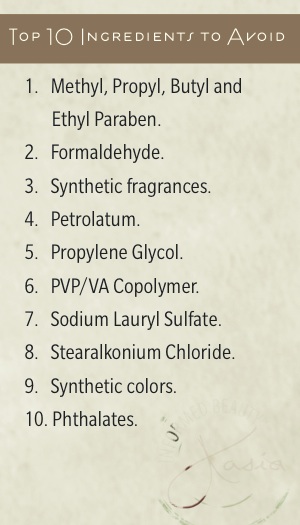Traditional beauty products can be loaded with toxins and chemicals, so it’s best to take the"Informed Beauty" route to the most natural products.
 DEA, TEA
Purpose/Usage: foaming agent
Avoid because: skin sensitizer, can form carcinogenic compounds when mixed with certain cosmetic ingredients
Products found in: makeup, body wash, shampoo, skincare
How to identify on a label: DEA, Diethanolamine, TEA, Triethanolamine
DEA, TEA
Purpose/Usage: foaming agent
Avoid because: skin sensitizer, can form carcinogenic compounds when mixed with certain cosmetic ingredients
Products found in: makeup, body wash, shampoo, skincare
How to identify on a label: DEA, Diethanolamine, TEA, Triethanolamine
Phthalates Purpose/Usage: often used as a carrier for synthetic fragrance Avoid because: can negatively affect fertility and fetal development, considered a probable carcinogen by the World Health Organizaiton Products found in: hair spray, lipstick, perfume and nail polish How to identify on a label: Benzylbutyl phthalate (BzBP), Di-n-butyl phthalate or Dibutyl phthalate (DBP), Diethyl phthalate (DEP), and sometimes Fragrance Formaldehyde Purpose/Usage: an impurity released by some chemical preservatives Avoid because: carcinogenic, skin and lung irritant, gastrointestinal or liver toxicant and neurotoxin Products found in: nail polish, deodorant, shampoo How to identify on a label: Formaldehyde, Formalin, Urea, Diazolidinyl urea, Imidazolidinyl urea, DMDM hydantoin, Quaternium-15, 2-bromo-2-nitropropane-1,3-diol, and Sodium hydroxylmethylglycinate Parabens Purpose/Usage: synthetic preservative Avoid because: found in breast tissue, acts like estrogen in the body, could lead to impaired fertility or fetal development Products found in: soap, skincare, body care, hair care, toothpaste, deodorant How to identify on a label: alkyl parahydroxybenzoate, butylparaben, methylparaben, ethylparaben, propylparaben, isobutylparabens
Ammonia/Hair Color Purpose/Usage: A gas with an extremely sharp, pungent, irritating odor. Avoid because: Repetitve contact will dry the skin and damage skin cells and eventually cause serious skin complications. Exposure to fumes will damage eyes, liver, kidneys, and lungs. Long term exposure to ammonia fumes can cause obesity, depression, and social anxiety disorder.
Products found in: Ammonia fumes come from the substance of Ammonia Hydroxide. It is commonly used in the hair color to open the hair cuticle How to identify on a label:
Petrolatum Purpose/Usage: used as an emollient or lubricant Avoid because: commonly contain impurities linked to cancer Products found in: skincare, body care, lip balm, makeup How to identify on a label: petrolatum, petroleum jelly, mineral oil Propylene Glycol Purpose/Usage: helps a product to retain moisture Avoid because: penetration enhancer (alters skin structure, allowing other chemicals to more easily enter the system) Products found in: skincare, hair care, body care, makeup, baby care products, contact lens cleaner How to identify on a label: Propylene Glycol, Proptylene Glycol, 1,2-Propanediol. Related synthetics: PEG (polyethylene glycol) and PPG (polypropylene glycol)
Sodium Lauryl/Laureth Sulfate Purpose/Usage: makes a product foamy Avoid because: penetration enhancer (alters skin structure, allowing other chemicals to more easily enter the system) Products found in: shampoo, facial cleansers, body wash, bubble bath, baby bath, toothpaste How to identify on a label: Sodium Laureth Sulfate, Sodium Lauryl Sulfate, Sodium Lauryl Ether Sulfate, Anhydrous Sodium Lauryl Sulfate, Irium 1,4 Dioxane Purpose/Usage: a chemical by-product of ethoxylation, an ingredient processing method used to make petro-ingredients less irritating to skin Avoid because: carcinogenic, suspected cardiovascular and blood toxicant, gastrointestinal toxicant, immunotoxicant, kidney toxicant, neurotoxicant, respiratory toxicant, skin toxicant Products found in: shampoo, facial cleansers, body wash, bubble bath, baby bath, liquid soap How to identify on a label: because 1,4 Dioxane is a contaminant produced during the manufacturing process, FDA does not require it to be listed on a product ingredient listing. Look for common ingredients which may contain the impurity, identifiable by the prefix or designations of 'PEG,' '–eth–,' 'Polyethylene,' 'Polyethylene glycol' 'Polyoxyethylene,' or '–oxynol–' (FDA 2007).
Synthetic Colorants (FD&C colors) Purpose/Usage: coal tar (petroleum) derived and commonly tested on animals due to their carcinogenic properties, used to artificially color a cosmetic product Avoid because: can cause skin irritation and allergic reactions Products found in: shampoo, facial cleansers, body wash, skincare, baby care products, hair care, makeup How to identify on a label: FD&C or D&C followed by a name and number (FD&C RED NO. 40)
Synthetic Fragrances Purpose/Usage: combination of chemical ingredients used to artificially scent a cosmetic product Avoid because: can cause allergic reactions, headache, dizziness, and rash (children tend to be particularly sensitive), respiratory distress, and possible effects to reproductive system Products found in: hair care, skin care, makeup, body care, perfume How to identify on a label: fragrance, parfum (It is important to note that the terms “fragrance” or “parfum” sometimes occur on an ingredient listing which contains natural fragrance ingredients and no chemical ingredients. This is most often due to manufacturer trade secret and should be disclosed on the label.) Synthetic Sunscreens Purpose/Usage: provide sun protection Avoid because: have been found to mimic estrogen in the body potentially causing hormonal disruption, can also cause skin irritation and easily absorb in to the skin Products found in: sunscreens, facial moisturizer, lip protection How to identify on a label: 4-Methyl-Benzylidencamphor (4-MBC), Oxybenzone Benzophenone-3, Octyl-methoyl-cinnamates (OMC), Octyl-Dimethyl-Para-Amino-Benzoic Acid (OD-PABA), Homosalate(HMS) Methylisothiazolinone (MIT) Purpose/Usage: widely used as a preservative Avoid because: possible neurotoxin, possible health risks to unborn babies, allergic reactions Products found in: hair care, body wash, sunscreen, skin care How to identify on a label: 3 (2h) -Isothiazolone, 2-Methyl-; Methylchloroisothiazolinone225methylisothiazolinone Solution; 2-Methyl-3 (2h) -Isothiazolone; 2-Methyl-4-Isothiazolin-3-One; 2-Methyl- 3 (2h) -Isothiazolone; 2-Methyl-2h-Isothiazol-3-One; 3 (2h) Isothiazolone, 2methyl; 2-Methyl-3 (2h) -Isothiazolone; 2-Methyl-4-Isothiazolin-3-One
Lead Purpose/Usage: a contaminant of chemical color additives Avoid because: a known neurotoxin, linked to brain damage, miscarriage, lowered IQ, increased aggression, and learning disabilities Products found in: many conventionally produced lipsticks contain lead, as do some nail polish, hair color, and whitening toothpastes How to identify on a label: C.I. 77575; Glover; Ks-4; Lead (Acgih) ; Lead Flake; Lead Inorganic; Lead S2; Olow (Polish)



 Use essential oils to promote hair health
Use essential oils to promote hair health